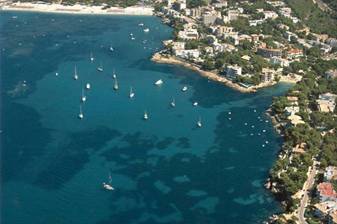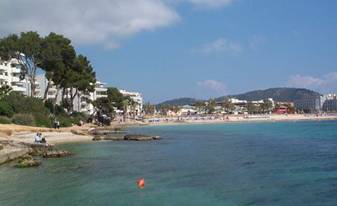
Platja de Santa Ponça está a siete kilómetros de Calvià, situada entre Punta des Castellot y Caló d’en Pellicer, formando una bahía de gran tamaño.
En este litoral se inició la conquista cristiana de Mallorca por la corona catalanoaragonesa para arrebatársela a los musulmanes almohades. El 10 de septiembre de 1229 desembarcó aquí el rey Jaume I y 20.000 soldados de 143 naves. El año 1929 se erigió una cruz gigantesca en la punta oriental que cierra esta rada, y da acceso al Club Náutico Santa Ponça, para conmemorar el 700 aniversario de este hecho.
Las viviendas residenciales, los alojamientos vacacionales y otros servicios destinados al turismo de masas forman el paisaje urbano de este enorme arenal, convirtiéndolo en uno de los principales núcleos turísticos calvianers. También recibe una afluencia masiva de bañistas locales, que frecuentan el pinar de la parte trasera de esta playa.
Sus condiciones marinas y subacuáticas son aptas para el fondeo de una embarcación, excepto cuando soplan vientos del sur-sureste-este por lo que se aconseja al navegante que cale en el cercano y resguardado Caló d’en Pellicer, con fondo de arena y alga, a una profundidad que oscila entre dos y cuatro metros. Frente a la orilla y casi en medio de la ensenada existe un bajo que está señalizado.
El acceso por carretera es sencillo siguiendo la señalización viaria. El vehículo particular se podrá estacionar de manera gratuita por sus alrededores. También se puede optar por el transporte público. El autobús para por sus inmediaciones.Alquiler de coche recomendado . Subir
Otros Hoteles en Palma , Playa de Palma , Arenal
more videos



Platja de Santa Ponça is situated at seven kilometres from Calvià, between Punta des Castellot and Caló d'en Pellicer, and it forms a big bay.
On this coastal stretch the Christian conquest of Majorca by the Catalans and Aragonian against the Arabs began. The king Jaume I and 20000 soldiers with 143 boats disembarked here on the 10th of September 1229. In 1929 a huge cross was built on the eastern end of this bay, where the access to Club Nàutic Santa Ponça is, as a commemoration of 700 years after this fact.
The urban landscape of this huge sandy area is characterized by the presence of residential houses, as well as touristic buildings and other facilities for mass tourism, and it is one of the most important touristic areas of Calvià. There is also an important influx of local visitors, who stay next to the pine wood at the rear of the beach.
The marine and underwater conditions for anchoring boats are good, except when the wind is blowing from the south-southeast-east, and this is why the navigator is recommended to anchor in the nearby and sheltered Caló d'en Pellicer, with a sandy ground with seaweed and the depth ranges from two to four metres. In front of the coast and in the middle of the bay there is a sandbank which is marked.
The accessibility by car is easy following the signs. The private car can be left on a free parking area. You can also reach this beach with the public transport. The nearest bus stop is located in the surroundings.Top
Otros Hoteles en Palma , Playa de Palma , Arenal

Platja de Santa Ponça ist sieben Kilometer von Calvià entfernt und liegt zwischen Punta des Castellot und Caló d’en Pellicer, die eine große Bucht bilden.
An diesem Küstenstrich begann die christliche Eroberung Mallorcas durch die katalanisch-aragonesische Krone, um die Insel den muselmanischen Almohaden zu entreißen. Am 10. September 1229 ging hier König Jaume I. mit seinen 20.000 Soldaten, die auf 143 Schiffen gekommen waren, an Lang. Im Jahr 1929 wurde ein riesiges Kreuz am östlichen Punkt der Reede errichtet, die die Zufahrt zum club Nàutic Santa Ponça bildet, um den 700. Jahrestag dieses Ereignisses zu würdigen.
Die Privathäuser, Ferienunterkünfte und andere Einrichtungen für den Massentourismus formen das urbane Bild dieses riesigen Strandes und machen aus ihm einen der wichtigsten Touristenorte der Gemeinde Calvià. Auch einheimische Badegäste suchen diesen Strand in großer Anzahl, hauptsächlich den Pinienwald in seinem hinteren Bereich auf.
Die Wasser- und Unterwasserbedingungen sind zum Ankern außer bei Süd-Südost-Ostwinden geeignet, weshalb Skippern empfohlen wird, eher im nahen und geschützten Caló d’en Pellicer auf Sand- und Algengrund bei einer Tiefe von zwei und vier Metern zu ankern. Gegenüber vom Ufer, fast in der Mitte der Bucht, gibt es eine markierte Untiefe.
Die Anfahrt mit dem Auto ist einfach, man folge der Beschilderung. Man kann gratis in der Nähe parken. Es gibt auch die Möglichkeit, mit dem öffentlichen Bus hierher zu gelangen; die Haltestelle befindet sich in unmittelbarer Nähe.Top
Hotels im Palma , Playa de Palma , Arenal





